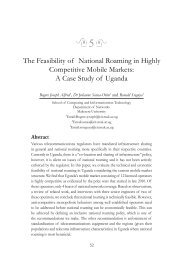John Matovu Aminah Zawedde Das Pamela and Herbert Ruhunde.pdf
John Matovu Aminah Zawedde Das Pamela and Herbert Ruhunde.pdf
John Matovu Aminah Zawedde Das Pamela and Herbert Ruhunde.pdf
You also want an ePaper? Increase the reach of your titles
YUMPU automatically turns print PDFs into web optimized ePapers that Google loves.
64 Strengthening the Role of ICT in Development Volume VIII<br />
There is a great need to build the capacity of people to enable their use of<br />
internet <strong>and</strong> basic ICTs such as mobile phones whose benefi ts are amplifi ed by the<br />
fact that the spread of mobile technology in many rural areas has occurred much<br />
faster than with other information <strong>and</strong> communication technologies (ICTs).<br />
There is also a need develop local content in local languages <strong>and</strong> applications in<br />
high utility value for the community. Areas to look into include: health, education,<br />
market information, agriculture <strong>and</strong> local administration.<br />
Although an exp<strong>and</strong>ing body of scholarly work addresses technological issues<br />
regarding journalism, few authors combine such insights <strong>and</strong> research into a<br />
broader framework of thinking about journalism <strong>and</strong> media production processes<br />
as a whole <strong>and</strong> this is where the gist should be.<br />
Similarly, work on new media <strong>and</strong> journalism signals increased interactivity <strong>and</strong><br />
a further blurring of the hierarchical relationships between producers <strong>and</strong> users<br />
of news as the main characteristics of the changes digitalization <strong>and</strong> convergence<br />
bring to conceptualizing journalism [Pavlik 2001].<br />
What sets the sketched developments in society <strong>and</strong> technology apart in<br />
their impact upon contemporary journalism is related issues of control <strong>and</strong><br />
transparency. Control on the one h<strong>and</strong> is about initiatives to remove primacy of<br />
authority over the news agenda or even the storytelling experience from the h<strong>and</strong>s<br />
of (professional) journalists in favour of more responsive, interactive <strong>and</strong> inclusive<br />
journalistic practices. Transparency on the other h<strong>and</strong> relates to the increasing<br />
ways in which people both inside <strong>and</strong> external to journalism are given a chance to<br />
monitor, check, criticize <strong>and</strong> even intervene in the journalistic process. One element<br />
enables <strong>and</strong> follows the other, of course: more shared control over newsgathering<br />
<strong>and</strong> storytelling increases opportunities for surveillance <strong>and</strong> procession criticism.<br />
The point here is that a rethinking of journalism <strong>and</strong> the professional identity<br />
of journalists is necessary not so much because there is something wrong with the<br />
profession, but rather because it is essential in order to maintain a conceptually<br />
coherent underst<strong>and</strong>ing of what journalism is in an increasingly complex <strong>and</strong><br />
liquid modern society [Bauman 2001].<br />
Stverak [2010] argues that these fears are unfounded because traditional<br />
news media reporters <strong>and</strong> editors are being devastated by a fi nancial crisis, not a<br />
journalism crisis. Somebody has to fi ll the void.<br />
He argues that those who work with citizen journalists in online news ventures<br />
know better than anyone what a tough, disciplined calling it is. That is why they<br />
hire professionals <strong>and</strong> rigorously train citizens.
















